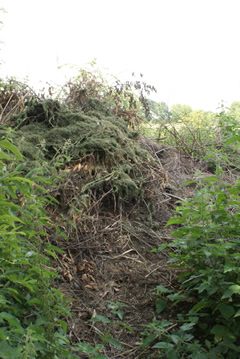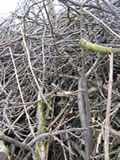Composting
No natural surplus material is removed from the plot or burned. There has not been a bonfire on this land since our arrival in 1995. All plant material, kitchen peelings, hedge-cuttings, grass-cuttings and all organic matter on the premises are composted.
Materials for composting are split four ways:
Woody materials

Woody hedge cuttings and woody shrubs which are slow to decompose are added to the "Wildlife heap" where it provides food and shelter to birds, insects, reptiles and mammals. It decays slowly over several years leaving a pile of nutritious soil beneath.

The Wildlife heap rises and falls through the year depending on the season and the kind of activity in the garden but it in general it stays at approximately the same size. It has never been burned and so contains a valuable resource to improve the underlying soil while providing a safe and tasty restaurant for various visiting creatures. All kinds of creatures live and breed in it including rabbits, snakes, birds (wren and willow warbler), butterfly larvae and a host of other insects. In summer it is surrounded by a ring of nettles.
The heap continues to 'digest' the trunks of the 3-metre tall, 12-metre long Leylandii hedge that stood at the front of the house until about 2005. The smaller branches of that large hedge were chipped using the local council's chipping service, bagged in large brown paper sacks and subsequently used as mulching on various areas in the garden. So even a whole hedge has 'disappeared' into the plot thanks to nature's decomposition.
Grass Cuttings
Lawn cuttings are put in the beech hedge bottom and act as a weed suppressant and a nutrient. Hay raked from the meadow is added to the Wildlife heap, used as a mulch around meadow tree trunks or left in "hayricks" which provide a valuable over-wintering habitat for insects, lizards and frogs.
Leaves

Leaves from the garden trees and shrubs (mainly Apple, Pear and Ash) are raked and put on a compost bay exposed to sun and rain to rot down into "leaf mould". In autumn the leaf mould is bagged and stored to await use as the finest compost in the garden. The vacant "plot" is then filled with the current season's leaf-fall.
By allowing large tracts of lawn to grow unmowed under the trees, fallen leaves (and windfall apples) are left to rot under the trees and recycle their goodness directly to their 'parents'.
This is good for the trees, the soil, the earthworms and the various creatures under the trees, as well as leaving less leaf-raking for us to do.
Other vegetation
Other softer vegetation is composted on open-air ("cold") compost heaps, one heap per calendar year. The heap has a weed-resistant material on its floor to limit the invasion of nettles into the pile and this is held in place by a couple of heavy wooden posts. Soft plant matter, kitchen peelings, a small amount of grass cuttings, a small number of leaves are added to the pile and left exposed to the sun and rain. At the end of the year, when the adjacent 'plot' becomes vacant it is turned over into it and left to complete its decomposition for a further year (i.e. all material on it will have been there between 13 and 23 months). It is then 'harvested' (see picture) leaving a vacant space for the new year's material. This can be done with just two heap positions but I have added a third so I can have a spot for new material prior to fully harvesting the previous 'plot'.
 |
Update 2021: |
